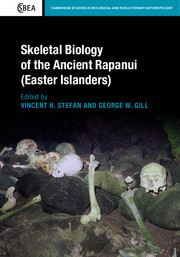Book contents
- Frontmatter
- Contents
- List of contributors
- Acknowledgements
- 1 Introduction: Research overview
- 2 Review of Polynesian and Pacific skeletal biology
- 3 Chronology and Easter Island prehistory
- 4 A descriptive skeletal biology analysis of the ancient Easter Island population
- 5 Craniometric variation of the prehistoric Polynesians and Rapanui
- 6 Rapanui non-metric cranial traits
- 7 Intra-island discrete cranial trait variation
- 8 Continuous non-metric characteristics of the early Rapanui
- 9 Rapanui dental morphology
- 10 Pelvic variability and sexual dimorphism in prehistoric Rapanui
- 11 Genetic affinities of the Rapanui
- 12 Archaeogenetics and paleodemographic estimation of founding populations: Features of residential geography on Rapa Nui
- 13 Evidence for injuries and violent death
- 14 Demographic analysis of modified crania from Rapa Nui
- 15 East Polynesian and Paleoindian parallels and contrasts in skeletal morphology
- 16 Rapanui origins, relationships, and warfare: A summary in theoretical context
- References
- Index
12 - Archaeogenetics and paleodemographic estimation of founding populations: Features of residential geography on Rapa Nui
Published online by Cambridge University Press: 05 December 2015
- Frontmatter
- Contents
- List of contributors
- Acknowledgements
- 1 Introduction: Research overview
- 2 Review of Polynesian and Pacific skeletal biology
- 3 Chronology and Easter Island prehistory
- 4 A descriptive skeletal biology analysis of the ancient Easter Island population
- 5 Craniometric variation of the prehistoric Polynesians and Rapanui
- 6 Rapanui non-metric cranial traits
- 7 Intra-island discrete cranial trait variation
- 8 Continuous non-metric characteristics of the early Rapanui
- 9 Rapanui dental morphology
- 10 Pelvic variability and sexual dimorphism in prehistoric Rapanui
- 11 Genetic affinities of the Rapanui
- 12 Archaeogenetics and paleodemographic estimation of founding populations: Features of residential geography on Rapa Nui
- 13 Evidence for injuries and violent death
- 14 Demographic analysis of modified crania from Rapa Nui
- 15 East Polynesian and Paleoindian parallels and contrasts in skeletal morphology
- 16 Rapanui origins, relationships, and warfare: A summary in theoretical context
- References
- Index
Summary
Introduction and research background
The standard interpretation of the bioarchaeology of Rapa Nui is inextricably linked to ethnohistoric accounts of a geographically and socially patterned population throughout much of its prehistory (McCall, 1979; McCoy, 1973; Métraux, 1940; Routledge, 1919; Stevenson, 1984, 2002). In addition, the occurrence and distribution of monumental architectural constructions (ahu, moai) on the island have been held up as a clear-cut case of population segmentation and social competition among competing clans within a restricted, marginal environment (Diamond, 1995; Kirch, 1989; Stevenson, 2002). Previous research has attempted to explain relatedness among the Rapanui through the analysis of artifacts, the study of the stylistic features and spatial patterning of monumental architecture (Martinsson-Wallin, 1994; McCoy, 1973; Rounds-Beardsley, 1990; Stevenson, 1984, 1986, 2002), but these studies have placed a large explanatory burden on the social or territorial descriptions of ethnographers who visited the island after most of its population had been lost to introduced disease and the slave trade (McCall, 1994).
The cultural discontinuity produced by the demographic collapse of the native population by 1880 raises questions about the physical congruity of the territorial and social descriptions from cultural informants obtained after this time. The well-studied nature of the spatial distribution of high-investment architecture, coupled with the salvage ethnographies (see Lavachery, 1936; Métraux, 1940; Routledge, 1919; Thomson, 1891) from the late nineteenth to middle twentieth century, have created a plausible and commonsense set of interpretations for the Late Prehistoric and Early Protohistoric era that have insinuated themselves into nearly all the scholarly work on Rapa Nui archaeology over the past 50 years. We believe part of the reason for the paucity of research on patterns of biological relatedness on the island is due to the presumption of stylistic unity or apparent relatedness of the large artifact classes, coupled with the continued influence of the notion of the territorial boundary as a construction of sociological importance (Rounds-Beardsley, 1990; Stevenson, 2002), which tends to reify explanations rather than structure hypotheses.
Here we present the results of our recent analysis of ancient microsatellite DNA from human skeletons as a separate data class to augment current archaeological, physical anthropological, and ethnohistoric explanations for the spatial distribution of monumental architecture and settlement and habitation patterns.
- Type
- Chapter
- Information
- Skeletal Biology of the Ancient Rapanui (Easter Islanders) , pp. 202 - 221Publisher: Cambridge University PressPrint publication year: 2016
- 1
- Cited by



